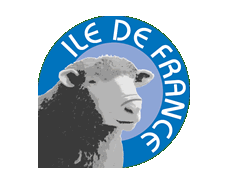 Ile de France Sheep
Ile de France Sheep
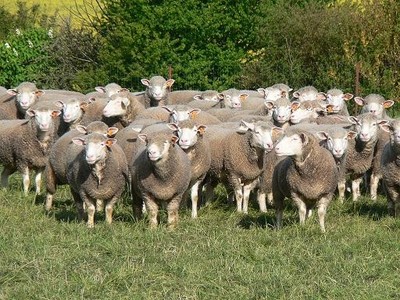
Breed Information
Extremely successful in France
 Developed in France starting in 1824
Developed in France starting in 1824
 The Ile de France Flock Book was established in 1982
The Ile de France Flock Book was established in 1982
 Most common meat sheep in France - 300,000 ewes or 22% of meat sheep
Most common meat sheep in France - 300,000 ewes or 22% of meat sheep
 Origin is the Dishley Leicester and Merino
Origin is the Dishley Leicester and Merino
 Performance recording started by the Ile de France Flock Book in 1933. By 1959,
Performance recording started by the Ile de France Flock Book in 1933. By 1959,
all sheep breeds in France had followed suit.
 In 1968 the Flock Book began batch testing progeny. In 1972, a test station was
In 1968 the Flock Book began batch testing progeny. In 1972, a test station was
opened at Verdilly, where Ile de France are tested and selected for meat
qualities and fertility.
An ability for off-season breeding
Lambings that can be programmed all year round :
<!--<!--<!--
The Ile de France is a thickly muscled, prolific sheep that has been used in France for both intensive out of season lamb production and spring pasture lamb production much as the Dorset has been used in the USA. The difference is that the Ile de France breed has lead the world utilizing cutting edge tools for genetic improvement for both maternal and terminal sire traits since 1933. The result is a breed that dominates as a female for intensive out of season lamb production and as a terminal sire for growth and carcass traits, not just in France but in 30 countries around the world.
Benefits derived from Ile de France breeding in any flock include larger loin eye area, improved lamb gains on pasture alone, broody mothers that keep tight to their lambs, improved herding ability, markedly improved lamb survival to weaning, higher ram labido resulting in more lambs born and lambing seasons lasting as little as 18 days.
Whether you are looking for a superb ewe to use on a pasture based system, an accelerated lambing system, or a sire to produce growthy, heavily muscled lambs, the Ile de France breed has a tremendous amount to offer.
Ile de France ewes have the particular feature and the advantage of having a sexual cycle in periods of increasing day lengths, unlike most meat breeds. This specific characteristic makes the work organisation much more flexible, and work peak periods can be spread out more easily. In an arable crop region, in particular, autumn lambing makes it possible to programme births during the periods when work in the fields has ceased.For others, distributing lambings over time is a way of using buildings and forage areas to the best advantage.

Beautiful appearance
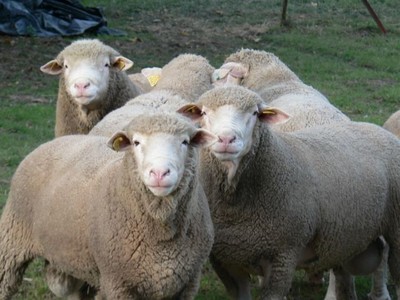
 Well proportioned
Well proportioned
 Excellent conformation
Excellent conformation
 Thickly muscled hind quarters
Thickly muscled hind quarters
 White, wooled sheep: Average fleece weight is 4 - 6 kg (9 - 13 pounds) with a 7 - 8 cm (2.75 - 3.2 inch) staple length and a count of 56 - 60.
White, wooled sheep: Average fleece weight is 4 - 6 kg (9 - 13 pounds) with a 7 - 8 cm (2.75 - 3.2 inch) staple length and a count of 56 - 60.
 Both sexes are polled
Both sexes are polled
 Average ewe weight 70 - 90 kg (154 - 198 pounds)
Average ewe weight 70 - 90 kg (154 - 198 pounds)
 Average ram weight 110 - 150 kg (242 - 330 pounds)
Average ram weight 110 - 150 kg (242 - 330 pounds)
 Withers height; males - 77 cm (30.3 inches); females - 67 cm (26.4 inches)
Withers height; males - 77 cm (30.3 inches); females - 67 cm (26.4 inches)

High level of balance between
Meat and maternal qualities :
Sheep breeds often have one striking quality, but are rarely a combination of several.
The Ile de France is one of the best breeds for meat conformation. Because of its conformation and speed of growth, it is widely used in industrial crossing with hardy breeds to supply the sheep meat industry. Meanwhile, its breed selection programme continues to improve its maternal qualities. In prolificacy and dairy value, the Ile de France is among the leaders of the meat breeds. The Ile de France ewe feeds its lambs naturally without any problems
Top quality lamb carcasses without excessive fat
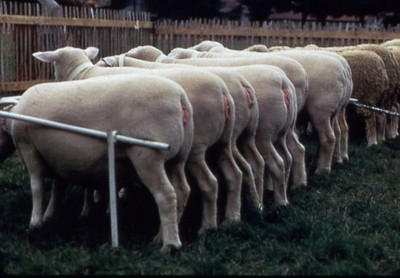
Good meat qualities
 Lean, well-muscled lamb with large rib eye area and good killing out percentage
Lean, well-muscled lamb with large rib eye area and good killing out percentage
 18 - 20 kg (40 - 44 pound) carcass at 3 - 4 months
18 - 20 kg (40 - 44 pound) carcass at 3 - 4 months
 Average daily gain of twin male lambs at 10 - 30 days: 251 grams (0.55 pounds)
Average daily gain of twin male lambs at 10 - 30 days: 251 grams (0.55 pounds)
 Average daily gain of single male lamb at 30 - 70 days: 361 grams (0.8 pounds)
Average daily gain of single male lamb at 30 - 70 days: 361 grams (0.8 pounds)
 19 - 20 kg (42 - 44 pounds) at 42 days of age
19 - 20 kg (42 - 44 pounds) at 42 days of age
 34 - 41 kg (75 - 90 pounds) at 100 days of age
34 - 41 kg (75 - 90 pounds) at 100 days of age
 Gain well on grass alone
Gain well on grass alone
 Excellent feed conversion
Excellent feed conversion

Hardy, easy care sheep
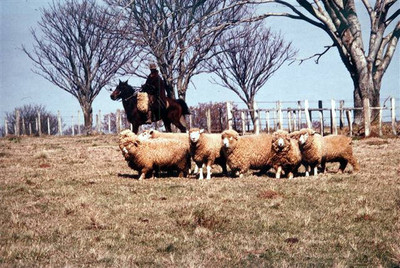
Ile de France Flock in Bresil
 Thrifty sheep that perform well on grass alone
Thrifty sheep that perform well on grass alone
 Very hardy, vigorous newborn lambs that are active and up and nursing in short
Very hardy, vigorous newborn lambs that are active and up and nursing in short
order
 Lambs average 4 kg (9 pounds) at birth so lambing problems are rare
Lambs average 4 kg (9 pounds) at birth so lambing problems are rare
 Lambs grow rapidly and have among the best daily live weight gains and feed
Lambs grow rapidly and have among the best daily live weight gains and feed
conversion in Europe
شاهد مزرعة لتربية أغنام الإيل دى فرانس على الرابط التالى
http://www.youtube.com/watch?v=hdyncEmKdps
<!--<!--[if gte mso 9]-->



ساحة النقاش